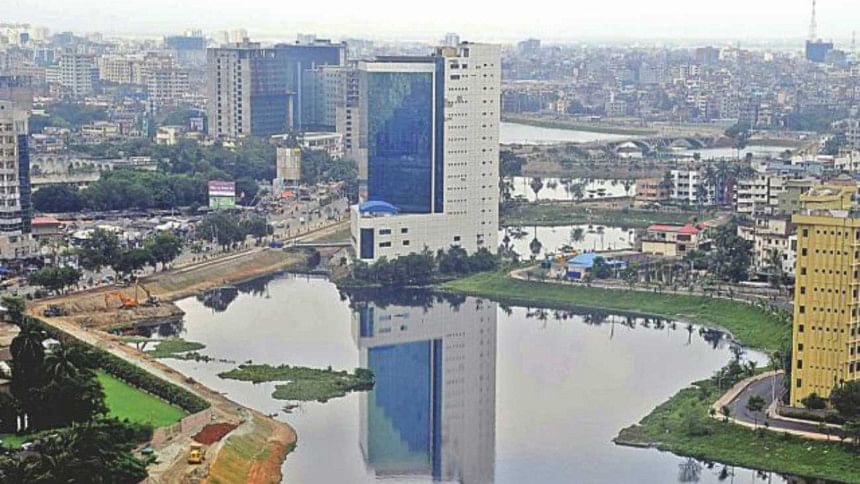BGMEA building – Carry out the court order immediately

How long does it take to bring down a 15-storeyed building? Certainly not three years. Yet that is how much time the BGMEA is seeking from the Supreme Court to dismantle the illegal building. The whole process of transfer of government land to a private body, and the construction of a high-rise building thereon, has been obtained, according to the verdict of the court, by deceit, duplicity, fraud and lack of transparency. And those who were involved in the process, according to the opinion of the court also, were fully cognisant of the fact that they were indulging in a blatant act of fraudulence. The BGMEA building displays dishonesty of a few perched at the apex of our social pyramid.
There was collusion at every stage in the process—from the sale of the land to registration and construction. We are told that the building plan was not even approved by Rajuk. And although it is known as BGMEA Building, most of the space of the structure that dominates the skyline has been sold out. Not only was the building constructed without approval, several other laws related to building construction were brazenly violated. And this brazenness stems from a feeling of power that money induces.
Going back to the original question of implementing the court's order of demolishing the building, why does it need three years to demolish the structure like that of the BGMEA building? The excuse offered by the BGMEA is puerile and one feels that the time of three months originally fixed by the High Court is very realistic. The attorney general has volunteered a suggestion, of one year, for the BGMEA to implement the court order. We wonder what the basis of his suggestion is. One cannot occupy something illegally and justify retention of the property because the owner is supposed to be "dealing with many important issues". The BGMEA had got plenty of time since the verdict was announced by the High Court in 2011. It should have made preliminary plans for all eventualities. It did not, hoping that the verdict would go its way. Alas!
The Association leadership are all respectable men. And many of them were perhaps not involved in the purchase of the land and construction of the building. It is a sore thumb, and none other than the Prime Minister of the country had described it as such, that stands mocking the society. And the only decent act on their part would be to see that the structure goes. And the sooner it goes the sooner would their image be retrieved. We have examples of high-rise buildings being decimated in no time. The Rangs Bhaban is an example. It was 22-storeyed and not the entire building was declared illegal. In fact the process of breaking it started the very day the final appeal was disposed of by the court. Although the demolition was done in a very primitive way, it was completed in much less than the one year's time that the attorney general has suggested for a party that he does not represent. I think we have now in this country much improved and better methods of going about demolition jobs.
The building should be an example to us for many things. It is an example of how money and connection can be misused to derive undue benefits to national detriment. And does having the foundation stone laid and the building inaugurated after construction by the heads of the government of the time consecrate a wrong?
There are two sides of the saga, one side of which the highest court has taken care of. Its decision only reinforces our faith and confidence in our higher judiciary. The other side of the story must also be taken into consideration and addressed in an equally objective manner by the government.
Shouldn't the various parties involved in the unholy alliance at all levels be called to account? Firstly, how was railway land sold by a body that did not own the land? And how was the sale registered by the Land Office in the first place?
Secondly, how did the construction firm involve itself in the construction of a building without an approved plan? Wasn't it the duty and responsibility of the company to double check whether the land records were valid and whether the plan had valid approval of the appropriate authorities, and that all the conditions related to building construction were fulfilled before the first spade dug into the ground?
Thirdly, the building was not constructed overnight. It took long eight years, from 1998 when the foundation was laid by one prime minister to 2006 when it was inaugurated by another. And did it not come to the notice of any government agency, not even Rajuk, that a brazenly illegal construction was going on? It was only after the building had been completed that Rajuk asked explanation from the BGMEA. Obviously, the temporary blindness of Rajuk, in respect of BGMEA that lasted eight years, was with a dubious motive.
Fourthly, how come other public service providers, like gas, electricity and water, and telephone, provide connections without verifying the legality of the building? Obviously all the indispensable conditions were thrown out of the window in this instance.
Not one or two or three but an entire horde of people was party to the flagrant violation of the law of the land. And not only must the BGMEA building be brought down without delay, all those who connived in the scheme must be brought to justice. It is time to establish the power of the rule of law over the power of money and unholy alliances.
The writer is Associate Editor, The Daily Star.

 For all latest news, follow The Daily Star's Google News channel.
For all latest news, follow The Daily Star's Google News channel. 








Comments